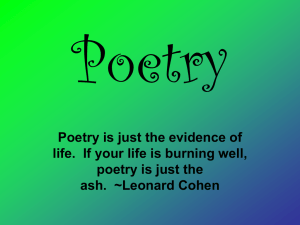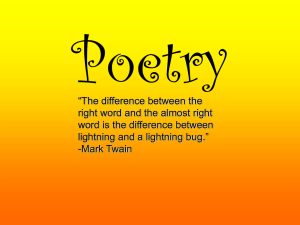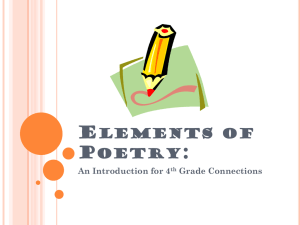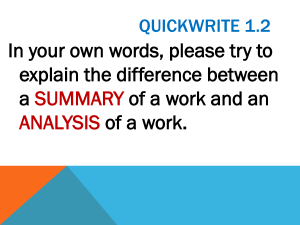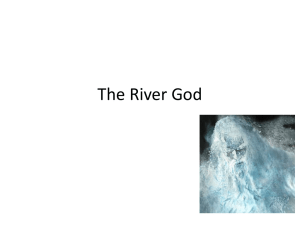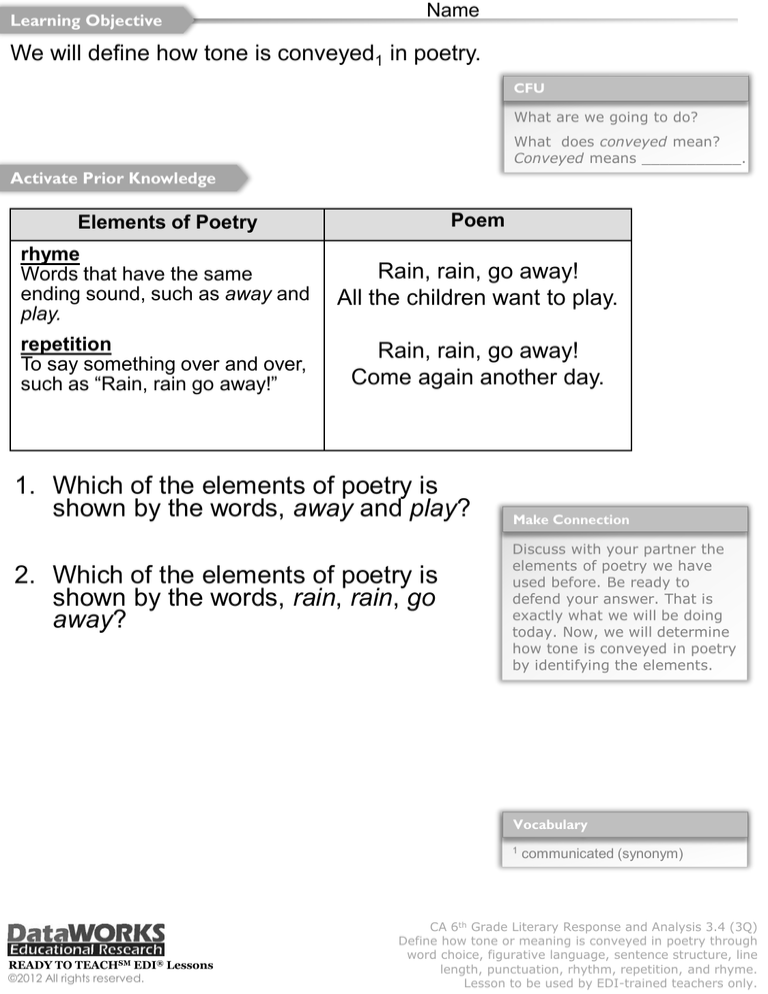
Learning Objective
Name
We will define how tone is conveyed1 in poetry.
CFU
What are we going to do?
What does conveyed mean?
Conveyed means ___________.
Activate Prior Knowledge
Elements of Poetry
Poem
rhyme
Words that have the same
ending sound, such as away and
play.
Rain, rain, go away!
All the children want to play.
repetition
To say something over and over,
such as “Rain, rain go away!”
Rain, rain, go away!
Come again another day.
1. Which of the elements of poetry is
shown by the words, away and play?
2. Which of the elements of poetry is
shown by the words, rain, rain, go
away?
Make Connection
Discuss with your partner the
elements of poetry we have
used before. Be ready to
defend your answer. That is
exactly what we will be doing
today. Now, we will determine
how tone is conveyed in poetry
by identifying the elements.
Vocabulary
1
READY TO TEACHSM EDI® Lessons
©2012 All rights reserved.
communicated (synonym)
CA 6th Grade Literary Response and Analysis 3.4 (3Q)
Define how tone or meaning is conveyed in poetry through
word choice, figurative language, sentence structure, line
length, punctuation, rhythm, repetition, and rhyme.
Lesson to be used by EDI-trained teachers only.
Concept Development
Poetry is a piece of writing that expresses emotions, experiences, and ideas.
•
Elements of poetry such as rhyme, repetition, and word choice often help convey the
tone of the poem.
Tone is the poet’s attitude2 toward the topic and/or readers.
• Tone can be playful, angry, disgusted, serious, happy, etc.
Elements of Poetry
1. rhyme
Words that have the same ending
sound, such as behold and cold.
2. repetition
To say something over and over,
such as, “Never on Sunday.
Never on Sunday,” etc.
3. rhythm
To say some syllables with more
force and others with less force.
4. word choice
Words that are used for an exact
meaning or emotions.
Poem
Bugs
Bugs, Bugs, Bugs.
Stupid bugs, nasty bugs. Repetition
Slimy, crunchy bugs.
Those are just a few.
Big bugs, disgusting bugs.
Word
Flying, jumping, buzzing bugs.
Choice
Annoying, sucking, working bugs.
Last of all—best of all—
I do not like any bugs at all.
Excerpted from Ben
Tone: The author’s tone is disgusted. The author hates bugs.
How does the author convey the tone? The author uses word choice to
convey exact meaning and his emotions towards bugs, such as stupid, slimy,
annoying, etc. Repetition was also used by the author to convey his hatred
for bugs.
CFU
Write an example of tone on your whiteboard.
What is the tone of the poem Another Day of School? Explain your answer.
Another Day of School
School, school, another day
Carry books. Go to class.
Sit and listen. Be quiet all the time.
School, school, another day.
School, school, I want to go home.
A. exciting
B. boring
In your own words, what is tone? Tone is ___________.
Vocabulary
2
©2012 All rights reserved.
opinions or feelings about
something
CA 6th Grade Literary Response and Analysis 3.4 (3Q)
Define how tone is conveyed in poetry.
Lesson to be used by EDI-trained teachers only.
Skill Development/Guided Practice
Tone is the poet’s attitude toward the topic and/or readers.
• Tone can be playful, angry, disgusted, serious, happy, etc.
Define how tone is conveyed in poetry.
1 Read each stanza3 carefully.
a Identify4 the words that represent the elements of poetry. (underline)
b Identify the elements of poetry. (label)
2 Define the poem’s tone. (circle)
3 Explain5 your answer. (write)
1. rhyme
Words that have the same
ending sound, such as
behold and cold.
2. repetition
To say something over
and over, such as, “Never
on Sunday. Never on
Sunday,” etc.
3. rhythm
To say some syllables
with more force and
others with less force.
4. word choice
Words that are used for
an exact meaning or
emotion.
Tree House
A tree house, a free house,
A secret you and me house,
A high up in the leafy branches
Cozy as can be house.
A street house, a neat house,
Be sure to wipe your feet house
Is not my kind of house at all –
Let’s go live in a tree house.
By Shel Silverstein
What is the tone of the poem?
A irritated (annoyed)
B indifferent (doesn’t care)
C playful
D uncomfortable
E your own: _____________
Explain:
CFU
1a How
1b How
2 How
3 How
did
did
did
did
I/you
I/you
I/you
I/you
identify words that represent the elements of poetry?
identify the elements of poetry?
define the poem’s tone?
explain my/your answer?
Vocabulary
3
group of lines
find (synonym)
5 describe (synonym)
4
©2012 All rights reserved.
CA 6th Grade Literary Response and Analysis 3.4 (3Q)
Define how tone is conveyed in poetry.
Lesson to be used by EDI-trained teachers only.
Skill Development/Guided Practice (continued)
Tone is the poet’s attitude toward the topic and/or readers.
• Tone can be playful, angry, disgusted, serious, happy, etc.
Define how tone is conveyed in poetry.
1 Read each stanza carefully.
a Identify the words that represent the elements of poetry. (underline)
b Identify the elements of poetry. (label)
2 Define the poem’s tone. (circle)
3 Explain your answer. (write)
1. rhyme
Words that have the same
ending sound, such as
behold and cold.
2. repetition
To say something over
and over, such as, “Never
on Sunday. Never on
Sunday,” etc.
3. rhythm
To say some syllables
with more force and
others with less force.
4. word choice
Words that are used for
an exact meaning or
emotion.
The Ghoul
The gruesome6 ghoul, the grisly7 ghoul,
without the slightest noise
waits patiently beside the school
to feast on girls and boys
He lunges fiercely though the air
as they come out to play,
and grabs a couple by the hair
and drags them far away.
Excerpted from Jack Prelutsky
What is the tone of the poem?
A frightening
B tender (gentle)
C friendly
D wise
E your own: _____________
Explain:
CFU
1a How
1b How
2 How
3 How
did
did
did
did
I/you
I/you
I/you
I/you
identify words that represent the elements of poetry?
identify the elements of poetry?
define the poem’s tone?
explain my/your answer?
Vocabulary
6
7
©2012 All rights reserved.
causing horror
terrible
CA 6th Grade Literary Response and Analysis 3.4 (3Q)
Define how tone is conveyed in poetry.
Lesson to be used by EDI-trained teachers only.
Relevance
Tone is the poet’s attitude toward the topic and/or readers.
• Tone can be playful, angry, disgusted, serious, happy, etc.
1
Defining how tone is conveyed in poetry will help you work in a
creative career.
If you want to be a songwriter, a screenwriter, or a poet, you need to
be able to determine what tone the words are conveying.
2
Defining how tone is conveyed in poetry will help you understand the
poet’s purpose.
The poet may use repetition to express an annoying tone, since
repeating things over and over can be frustrating.
3
Defining how tone is conveyed in poetry will help you do well on
tests.
Sample Test Question:
1. How does the poet achieve her tone?
A
B
C
D
4
She sets the poem in a public park.
She describes familiar things in a surprising way.
She uses lines in varying lengths.
She contrasts the swan with other birds.
Defining how tone is conveyed in poetry will help you be
a better writer.
CFU
Does anyone else have a reason why it is relevant to define how tone is
conveyed in poetry? (Pair-Share) Why is it relevant to define how tone is
conveyed in poetry? You may give me one of my reasons or one of your own.
Which reason is most relevant to you? Why?
©2012 All rights reserved.
CA 6th Grade Literary Response and Analysis 3.4 (3Q)
Define how tone is conveyed in poetry.
Lesson to be used by EDI-trained teachers only.
Tone is the poet’s attitude toward the topic and/or readers.
• Tone can be playful, angry, disgusted, serious, happy, etc.
Skill Closure
Define how tone is conveyed in poetry.
1 Read each stanza carefully.
a Identify the words that represent the elements of poetry. (underline)
b Identify the elements of poetry. (label)
2 Define the poem’s tone. (circle)
3 Explain your answer. (write)
Elements of Poetry
Poem
Fall
The color of leaves and life,
has vanished!
Green,
has vanished!
The empire of leaves,
lies in ruins!
lies in ruins!
1. rhyme
Words that have the same ending
sound, such as behold and cold.
2. repetition
To say something over and over, such
as “Never on Sunday. Never on
Sunday,” etc.
3. rhythm
To say some syllables with more force
and others with less force.
4. word choice
Words that are used for an exact
meaning or emotion.
From “Chrysalis Diary” by Paul Fleischman
What is the tone of the poem?
A blissful (joyful)
B utilitarian (useful)
C scary (frightening)
D bleak (hopeless; joyless)
E your own: _____________
Explain:
Constructed Response Closure
Albert defined the tone of the Fall poem above as “playful”. Explain why Albert is incorrect.
________________________________________________________
________________________________________________________
Summary Closure
What did you learn today about defining how tone is conveyed in poetry? (PairShare)
Day 1 ____________________________________________________________
_________________________________________________________________
Day 2 ____________________________________________________________
_________________________________________________________________
©2012 All rights reserved.
CA 6th Grade Literary Response and Analysis 3.4 (3Q)
Define how tone is conveyed in poetry.
Lesson to be used by EDI-trained teachers only.
Name
Independent Practice
Tone is the poet’s attitude toward the topic and/or readers.
• Tone can be playful, angry, disgusted, serious, happy, etc.
Define how tone is conveyed in poetry.
1 Read each stanza carefully.
a Identify the words that represent the elements of poetry. (underline)
b Identify the elements of poetry. (label)
2 Define the poem’s tone. (circle)
3 Explain your answer. (write)
Elements of Poetry
1. rhyme
Words that have the
same ending sound,
such as behold and
cold.
2. repetition
To say something over
and over, such as
“Never on Sunday.
Never on Sunday,” etc.
Poem
Two More Days Till School
I'm finally going to school this year,
and now the big day's almost here.
I'll learn to write and count and read-Only two more days till school.
I got new pants and shirts and socks,
a brand-new red and blue lunch box;
I'll paint and sing and dance and
play-Only one more day till school.
My hair is washed, my sneakers
squeak,
I'm so excited, I can hardly speak!
New things to do, new friends to
meet-Hooray! It's the first day of school!
By Leslie Kimmelman
3. rhythm
To say some syllables
with more force and
others with less force.
What is the tone of the poem?
4. word choice
Words that are used for
an exact meaning or
emotion.
©2012 All rights reserved.
A
B
C
D
E
Explain:
serene (peaceful)
excited (very happy)
boring
scary
your own: _____________
CA 6th Grade Literary Response and Analysis 3.4 (3Q)
Define how tone is conveyed in poetry.
Lesson to be used by EDI-trained teachers only.
Independent Practice (continued)
Tone is the poet’s attitude toward the topic and/or readers.
• Tone can be playful, angry, disgusted, serious, happy, etc.
Define how tone is conveyed in poetry.
1 Read each stanza carefully.
a Identify the words that represent the elements of poetry. (underline)
b Identify the elements of poetry. (label)
2 Define the poem’s tone. (circle)
3 Explain your answer. (write)
Elements of Poetry
1. rhyme
Words that have the same
ending sound, such as
behold and cold.
2. repetition
To say something over and
over, such as “Never on
Sunday. Never on Sunday,”
etc.
3. rhythm
To say some syllables with
more force and others with
less force.
4. word choice
Words that are used for an
exact meaning or emotion.
©2012 All rights reserved.
Poem
Rain
Drip drop
Drip drop, drip drop,
darned rain won't stop.
Dropping on my windowpane,
it is driving me insane.
By Bruce Lansky
What is the tone of the poem?
A exasperated (annoyed)
B blissful (very happy)
C utilitarian (useful)
D whimsical (playful)
E your own: _____________
Explain:
CA 6th Grade Literary Response and Analysis 3.4 (3Q)
Define how tone is conveyed in poetry.
Lesson to be used by EDI-trained teachers only.
Name
Periodic Review 1
Tone is the poet’s attitude toward the topic and/or readers.
• Tone can be playful, angry, disgusted, serious, happy, etc.
Define how tone is conveyed in poetry.
1 Read each stanza carefully.
a Identify the words that represent the elements of poetry. (underline)
b Identify the elements of poetry. (label)
2 Define the poem’s tone. (circle)
3 Explain your answer. (write)
Elements of Poetry
Poem
Fire and Ice
Some say the world will end in fire,
Some say in ice.
From what I’ve tasted of desire
I hold with those who favor fire.
But if it had to perish twice,
I think I know enough of hate
To say that for destruction ice
Is also great
And would suffice.
1. rhyme
Words that have the
same ending sound,
such as behold and
cold.
2. repetition
To say something over
and over, such as
“Never on Sunday.
Never on Sunday,” etc.
3. rhythm
To say some syllables
with more force and
others with less force.
4. word choice
Words that are used for
an exact meaning or
emotion.
©2012 All rights reserved.
By Robert Frost
What is the tone of the poem?
A
B
C
D
E
Explain:
worried
hopeful
joyous
indifferent (doesn’t care)
your own: _____________
CA 6th Grade Literary Response and Analysis 3.4 (3Q)
Define how tone is conveyed in poetry.
Lesson to be used by EDI-trained teachers only.
Name
Periodic Review 2
Tone is the poet’s attitude toward the topic and/or readers.
• Tone can be playful, angry, disgusted, serious, happy, etc.
Define how tone is conveyed in poetry.
1 Read each stanza carefully.
a Identify the words that represent the elements of poetry. (underline)
b Identify the elements of poetry. (label)
2 Define the poem’s tone. (circle)
3 Explain your answer. (write)
Elements of Poetry
Poem
I’m Nobody! Who are You?
I’m nobody! Who are you?
Are you nobody, too?
Then there’s a pair of us—don’t tell!
They’d banish us, you know.
1. rhyme
Words that have the
same ending sound,
such as behold and
cold.
2. repetition
To say something over
and over, such as
“Never on Sunday.
Never on Sunday,” etc.
3. rhythm
To say some syllables
with more force and
others with less force.
4. word choice
Words that are used for
an exact meaning or
emotion.
©2012 All rights reserved.
How dreary to be somebody!
How public, like a frog
To tell your name the livelong day
To an admiring bog!
By Emily Dickinson
What is the tone of the poem?
A
B
C
D
E
Explain:
disconnected (alone, outside)
silly
embarrassed
frightened (scared)
your own: ______________
CA 6th Grade Literary Response and Analysis 3.4 (3Q)
Define how tone is conveyed in poetry.
Lesson to be used by EDI-trained teachers only.
Name
Periodic Review 3
Tone is the poet’s attitude toward the topic and/or readers.
• Tone can be playful, angry, disgusted, serious, happy, etc.
Define how tone is conveyed in poetry.
1 Read each stanza carefully.
a Identify the words that represent the elements of poetry. (underline)
b Identify the elements of poetry. (label)
2 Define the poem’s tone. (circle)
3 Explain your answer. (write)
Elements of Poetry
Poem
This is Just to Say
I have eaten
the plums
that were in
the icebox1
and which
you were probably
saving
for breakfast
Forgive me
they were delicious
so sweet
and so cold
1. rhyme
Words that have the
same ending sound,
such as behold and
cold.
2. repetition
To say something over
and over, such as
“Never on Sunday.
Never on Sunday,” etc.
3. rhythm
To say some syllables
with more force and
others with less force.
By William Carlos Williams
What is the tone of the poem?
4. word choice
Words that are used for
an exact meaning or
emotion.
A
B
C
D
E
Explain:
disconnected (alone, outside)
silly
embarrassed
frightened (scared)
your own: ______________
Vocabulary
1
©2012 All rights reserved.
refrigerator
CA 6th Grade Literary Response and Analysis 3.4 (3Q)
Define how tone is conveyed in poetry.
Lesson to be used by EDI-trained teachers only.
Blank Page
©2012 All rights reserved.
CA 6th Grade Literary Response and Analysis 3.4 (3Q)
Define how tone is conveyed in poetry.
Lesson to be used by EDI-trained teachers only.

